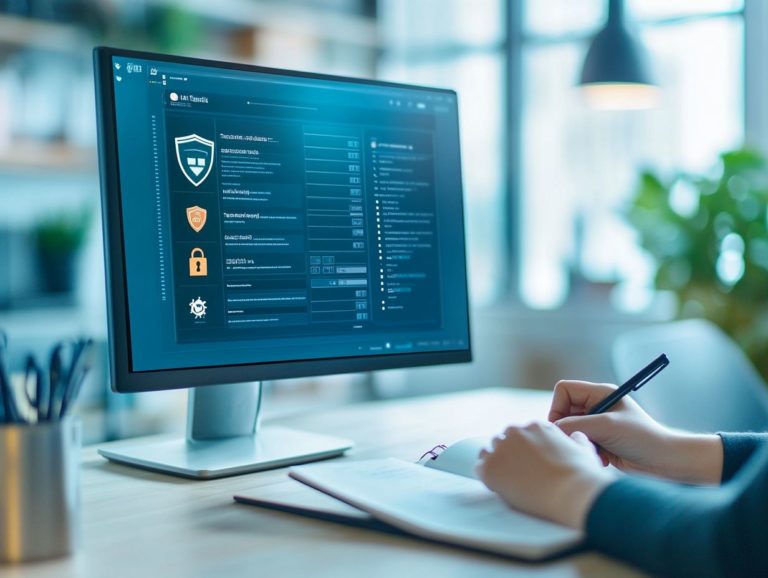creating a culture of cybersecurity awareness
In today’s digital landscape, grasping the nuances of cybersecurity awareness is more vital than ever. As you and your organization navigate many cyber threats, recognizing these risks and their potential impacts is essential for safeguarding sensitive information.
This article discusses the importance of cultivating a culture of cybersecurity awareness. It highlights the necessity of a top-down approach and thorough employee training. It addresses common threats, teaches you how to identify them, and shares best practices to elevate your cybersecurity posture.
Stay informed and empowered to protect yourself and your organization effectively.
Contents
Key Takeaways:

The Importance of Cybersecurity Awareness
In today s fast-paced digital landscape, the significance of cybersecurity awareness is paramount. Organizations are constantly bombarded with cyber threats, from phishing scams to complex cybercrime.
Cultivating a strong cybersecurity culture within your organization is essential. It empowers employees to become vigilant protectors of sensitive information and learn how to engage employees in security awareness.
By rolling out comprehensive awareness programs and weaving cybersecurity practices into the fabric of your organizational culture, you can dramatically diminish the risk of security breaches. This approach promotes a proactive stance on information security at every level.
Understanding the Risks
Understanding the many risks associated with cyber threats is crucial for you and your organization. This understanding helps strengthen defenses against potential data breaches and phishing attacks.
These threats can take many forms malicious software that demands payment to restore access to your files, attacks that make services unavailable, and insider threats. Each brings unique consequences that could jeopardize your financial stability and undermine morale and trust within your organization.
When your employees are aware of these dangers, they contribute to cultivating a culture of security. This makes vigilance a part of their daily routine.
Implementing effective risk assessment techniques, such as regular audits and comprehensive employee training sessions, empowers your team to identify vulnerabilities and respond appropriately.
Embracing continuous learning is vital, as the landscape of cyber threats is always shifting. Prioritizing education and proactive measures ensures your organization stays one step ahead.
Impact on Individuals and Organizations

The impact of cybersecurity threats goes far beyond financial loss. It can erode trust, tarnish reputations, and destabilize organizations.
This reality underscores the critical importance of implementing effective cybersecurity practices. Consider the high-profile data breaches faced by companies like Target and Equifax.
The aftermath wasn t just lost revenue; it involved legal ramifications and long-lasting damage to their public image.
These events serve as a clear reminder that safeguarding data isn’t solely the tech team’s job. Leadership must actively lead in cultivating a culture of cybersecurity awareness throughout the organization.
By engaging employees in comprehensive training and awareness programs, you can empower your workforce to identify and respond to potential threats proactively. This approach reduces vulnerabilities and significantly enhances the overall security posture of your organization.
Creating a Culture of Cybersecurity Awareness
Creating a culture of cybersecurity awareness within your organization begins with robust leadership. A steadfast commitment to integrating how to foster a culture of risk awareness into the workplace is essential.
This approach ensures that every employee comprehensively understands their role in safeguarding sensitive information against ever-evolving cyber threats.
Don’t wait until it’s too late start building a cybersecurity culture today!
Top-Down Approach
A top-down approach to cybersecurity means that as a leader, you actively promote training and awareness programs. This sets a clear culture that prioritizes information security.
When you participate in these initiatives, you highlight the importance of protecting sensitive data. This creates an environment where employees feel valued and acknowledged.
For instance, a leading tech company improved its security posture significantly through regular executive-led training sessions. These sessions educated staff about potential threats and showed that management cares about their development and security.
As a result, employee participation in training soared. This shift demonstrated that when leaders champion a cause, it can transform perspectives across the organization, enhancing awareness and readiness among all team members.
Employee Training and Education

Employee training is vital for equipping you with the skills to recognize and respond to cyber threats. This enhances your organization’s overall information security.
Training programs include hands-on workshops and interactive campaigns to build practical understanding. By participating in simulated phishing attacks and real-life scenarios, you gain valuable experience that sharpens your vigilance.
Ongoing education keeps you updated with the ever-evolving cybersecurity landscape. Statistics show that organizations with regular training cut security incidents by 70%. Well-informed personnel are significantly less likely to fall victim to attacks.
Common Cybersecurity Threats
You face a landscape of ever-changing cybersecurity threats. Organizations are increasingly vulnerable to phishing attacks, data breaches, and various cybercrimes.
Types of Attacks
Phishing attacks, ransomware, and DDoS attacks are key threats you must tackle. Each operates uniquely and can have devastating consequences for your business.
For example, phishing attacks use deceptive emails to trick employees into sharing sensitive information or downloading malware. Ransomware encrypts critical data and demands payment for its release, halting operations.
DDoS attacks overwhelm servers with excessive traffic. This strains resources and makes services inaccessible.
A notable incident involved a healthcare provider that suffered a ransomware attack, affecting thousands of patient records.
To counter these threats, implement the following measures:
- Focus on robust employee training.
- Ensure regular software updates.
- Utilize sophisticated monitoring systems.
How to Identify and Respond to Threats

Identifying and responding to cybersecurity threats requires a proactive approach. This includes effective practices, thorough risk assessment, and clear security policies.
To safeguard your digital environment, leverage advanced technologies like artificial intelligence and machine learning. These tools can analyze vast data volumes to detect unusual behavior hinting at potential threats.
Establish clear procedures for incident response and recovery. Everyone must understand their roles during a security breach to ensure a prompt reaction.
Equally important is fostering a culture of vigilance among your team. Engaged employees become your first line of defense, significantly enhancing your organization s overall security posture.
Best Practices for Cybersecurity
Using good security habits is crucial for protecting sensitive information and minimizing the risk of security breaches.
Strategies like multi-factor authentication a security method that requires two or more forms of identification and clearly defined security policies are vital components in this effort.
By prioritizing these measures, you can enhance your security posture and ensure greater peace of mind.
Implementing Strong Passwords
Strong password policies are a cornerstone of effective cybersecurity practices and serve as your first line of defense against unauthorized access to sensitive data.
Not all passwords are created equal. Focus on complexity and encourage yourself and your team to create passwords that are lengthy and incorporate a mix of upper and lower case letters, numbers, and special symbols.
Regularly updating passwords can significantly reduce the risks of data breaches. To elevate your security even further, consider implementing multi-factor authentication.
This adds an extra layer of protection, ensuring that access is granted only to those who truly belong.
Training sessions on best practices empower you and your colleagues. These sessions reinforce the importance of following strong security protocols.
Regularly Updating Software and Systems
Updating your software and systems regularly is crucial to protect against security breaches! Don t wait until it s too late!
Outdated applications can unwittingly become gateways for cyber threats, and each unpatched vulnerability can serve as an inviting entry point for attackers.
Automating updates ensures your software remains current and relieves your IT teams from the constant pressure of manual patches, allowing them to focus on more strategic initiatives.
Training programs equip your employees with the knowledge to identify the dangers posed by outdated software and cultivate a culture that prioritizes security.
When everyone understands the risks of ignoring updates, they actively help defend against threats!
Backing Up Data
Backing up data is an essential cybersecurity practice that gives you the power to mitigate the risks tied to data breaches. The time to back up your data is now!
In today s increasingly digital landscape, embracing a variety of data backup methods is paramount for protecting your crucial information. You have an array of strategies at your disposal.
From using cloud storage solutions that offer scalability and automatic backups to utilizing local storage devices like external hard drives for immediate data access, the options are plentiful.
Regular backups are a critical safety net. They are your best defense against irreversible data loss and significantly accelerate recovery times after an attack.
Conducting thorough risk assessments helps you spot weaknesses quickly and guides you in crafting tailored, effective backup strategies that align with your specific operational needs.
Frequently Asked Questions
What is a culture of cybersecurity awareness?
A culture of cybersecurity awareness refers to an organizational mindset and set of behaviors that prioritize and promote safe practices for protecting sensitive information from cyber threats, highlighting the impact of cybersecurity culture on businesses.
Why is creating a culture of cybersecurity awareness important?
Creating a culture of cybersecurity awareness is crucial because it can significantly reduce the risk of cyber attacks and data breaches. It also helps build a strong defense against cyber threats.
How can I promote a culture of cybersecurity awareness in my organization?
There are several ways to promote a culture of cybersecurity awareness, such as conducting regular training programs, establishing clear security protocols, and fostering a security-conscious workforce by encouraging employees to report suspicious activities.
What are some common cyber threats that a culture of cybersecurity awareness can help prevent?
A culture of cybersecurity awareness can help prevent various cyber threats, such as phishing attacks, malware infections, ransomware attacks, and the role of feedback in cybersecurity culture against social engineering scams.
Is creating a culture of cybersecurity awareness a one-time effort?
No, creating a culture of cybersecurity awareness is an ongoing effort. It requires consistent training, reinforcement, and updates to security protocols, such as learning how to implement effective security awareness training, to stay ahead of evolving cyber threats.
How can I measure the success of a culture of cybersecurity awareness in my organization?
The success of a culture of cybersecurity awareness can be measured through various methods, such as tracking reported incidents, conducting regular security audits, and monitoring employee compliance with security protocols.






